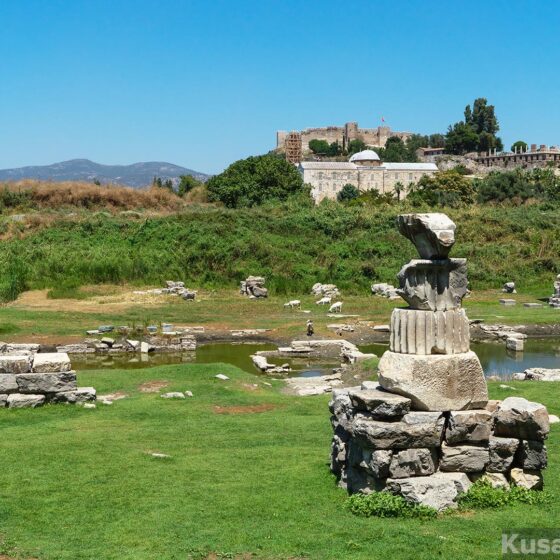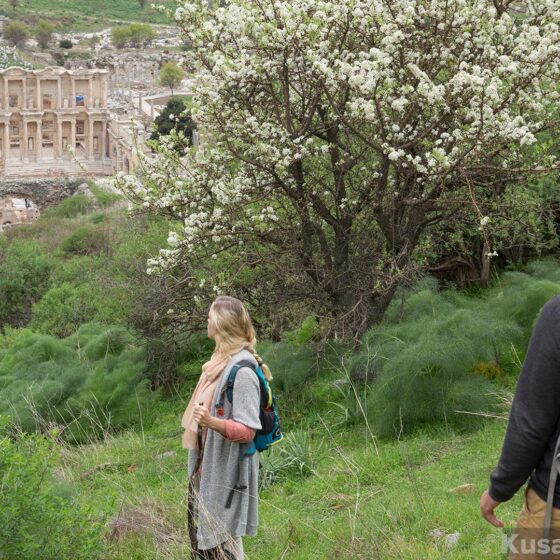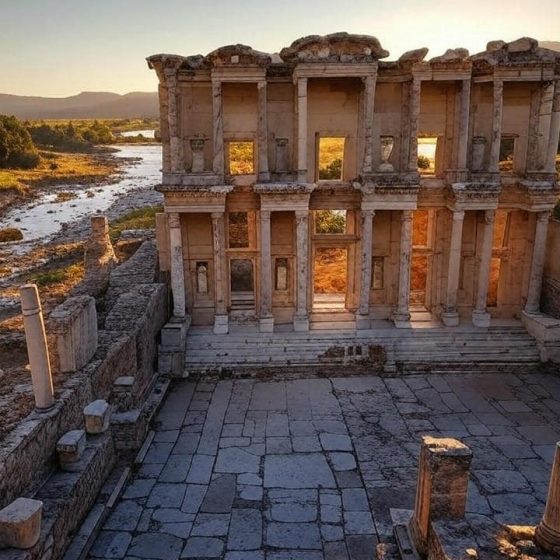Table of Contents Show
Ephesus is best known for its grand Library of Celsus, the Great Theatre, and the ruins of the Temple of Artemis. But beyond these famous landmarks, the city is filled with hidden stories and forgotten corners. The streets, fountains, and ancient buildings still hold the whispers of emperors, merchants, philosophers, and ordinary citizens who once called this city home.
For travellers who want to go beyond the usual tourist spots, these 10 locations reveal a deeper side of Ephesus, let’s get started!
Curetes Street: The Beating Heart of Ephesus
Walking down Curetes Street today, you follow the same path that elite Romans, wealthy merchants, and powerful officials once walked. This main road, which connected the Hercules Gate to the Library of Celsus, was lined with shops, statues, fountains, and public buildings.
Its name comes from the Curetes, priests of Artemis who played an essential role in religious ceremonies. Their influence is carved into the very stones of this street. As you walk, you will see inscriptions left by politicians and wealthy benefactors, proof of their contributions to the city.
Hidden Secret: The marble slabs covering the street were designed to keep dust down and provide a smooth surface for chariots. But beneath them, an underground drainage system kept the city clean—one of the earliest examples of urban planning.
Hercules Gate: A Monument to Strength
This gate once marked the entrance to the wealthiest part of Ephesus. Built in the 2nd century AD, it features reliefs of Hercules, the legendary hero known for his strength.
The passage is deliberately narrow, preventing chariots from passing through, which turned this section into a pedestrian-only zone. It also acted as a form of security, limiting access to the city’s elite residential area.
Hidden Secret: Some historians believe that touching the reliefs of Hercules brought good luck, as he was seen as a protector against evil spirits.
Fountain of Trajan: A Gift to the Emperor
The Fountain of Trajan, built in the early 2nd century AD, was one of the most impressive water structures in Ephesus. Dedicated to Emperor Trajan, the fountain once had a massive statue of the emperor standing over a large pool of water, with smaller statues of gods and heroes surrounding him.
The fountain symbolized the emperor’s divine power and Rome’s engineering skills in providing fresh water to its people.
Hidden Secret: The partially destroyed statue of Trajan’s foot remains, and visitors can still see the inscription marking him as ruler of the known world.
Temple of Hadrian: The Emperor Who Loved Ephesus
Hadrian, one of Rome’s most well-traveled emperors, visited Ephesus twice. The Temple of Hadrian, built in his honour, is one of the best-preserved monuments in the city.
Its decorative frieze tells the legend of Androklos, the founder of Ephesus, who followed an oracle’s prophecy to settle in this region. The intricate carvings also depict scenes of gods, emperors, and mythical creatures.
Hidden Secret: A small carving of Medusa sits above the entrance, meant to ward off evil spirits and protect the temple.
Terrace Houses
Many visitors walk past the Terrace Houses without realizing that they hold some of the finest Roman mosaics and frescoes outside of Italy. These were the homes of Ephesus’s wealthiest citizens, built on the slopes overlooking the city.
The marble floors, elaborate wall paintings, and private bathhouses show a world of luxury. Unlike ordinary homes, these residences had underfloor heating systems, proving that comfort and wealth went hand in hand.
Hidden Secret: The houses were connected by a private road, separate from the city’s main streets, allowing the elite to move unnoticed.
Odeon: The Political Theatre
Unlike the Great Theatre, which hosted thousands, the Odeon was a small, covered theatre used for political meetings, poetry readings, and music performances. With a seating capacity of around 1,500, it was an intimate space where city officials gathered.
Ephesus was not just a city of trade but also a center of intellectual and political debate. Here, citizens would discuss laws, elect leaders, and even listen to philosophers and poets.
Hidden Secret: The roof of the Odeon was made of wood, which improved acoustics but also made it vulnerable to fires.
Prytaneion: The Eternal Flame of Ephesus
The Prytaneion was the political heart of Ephesus, where leaders and high-ranking officials met to govern the city. It was also the site of the eternal sacred flame, which symbolized the city’s life force.
Only the most important guests, such as foreign ambassadors and visiting emperors, were welcomed here. The building also housed statues of Artemis, Athena, and other gods, representing the spiritual and civic life of Ephesus.
Hidden Secret: Excavations here uncovered two of the most famous statues of Artemis, which are now displayed in the Ephesus Museum.
Varius Bath: The Roman Spa Experience
The Varius Bath was one of several public baths in Ephesus, showing how important bathing culture was in Roman society. More than just a place to clean oneself, these baths were social spaces, where people gathered to discuss business, politics, and daily gossip.
The cold, warm, and hot bathing system followed the classic Roman model, allowing bathers to gradually adjust to different temperatures.
Hidden Secret: The bath’s mosaic floors featured intricate geometric patterns, some of which can still be seen today.
State Agora: The City’s Power Center
While the Commercial Agora was the marketplace of Ephesus, the State Agora was where important political and administrative meetings took place.
Built during the Hellenistic period, this large square was the seat of government, where officials controlled trade, taxes, and legal matters. It was a space restricted to politicians, priests, and powerful merchants.
Hidden Secret: An underground passage connected the State Agora to other government buildings, used by officials to move discreetly.
Magnesian Gate: The Gateway to Ephesus
The Magnesian Gate was one of the main entrances to Ephesus. It connected the city to major roads leading to other important trade centers, including Smyrna (modern-day Izmir).
It was a checkpoint where travellers, traders, and visitors had to register and declare their business before entering. Guards controlled access, ensuring that Ephesus remained safe from invaders and undesired visitors.
Hidden Secret: The gate’s foundations are much older than the visible ruins, suggesting it was rebuilt multiple times over the centuries.
Ephesus Beyond the Tourist Path
The famous landmarks of Ephesus tell only part of the story. Walking through Curetes Street, standing before the Prytaneion, or sitting in the Odeon allows travelers to experience the city’s past more deeply. Each stone, inscription, and relief carries a message from the merchants, politicians, emperors, and priests who shaped Ephesus.
For those who want to see more than just the usual ruins, these sites reveal the true complexity of one of the greatest cities of the ancient world.
FAQ
What is Curetes Street in Ephesus?
Curetes Street was one of the main roads in ancient Ephesus, connecting the Library of Celsus to the upper city. It was lined with statues, fountains, and important buildings, making it a key route for merchants and politicians.
Why is the Prytaneion important in Ephesus?
The Prytaneion was the political and religious heart of Ephesus. It housed the sacred eternal flame, which symbolized the city’s life force, and was where officials met to govern and hold ceremonies.
What makes the Temple of Hadrian special?
The Temple of Hadrian is one of the best-preserved structures in Ephesus, known for its detailed carvings that depict the city’s legendary founder, Androklos. A Medusa relief above the entrance was placed to ward off evil.
Are the Terrace Houses worth visiting in Ephesus?
Yes, the Terrace Houses offer a unique look into the daily lives of Ephesus’s wealthiest residents. The homes have stunning mosaics, frescoes, and even an early underfloor heating system, showcasing Roman luxury.
Where was the political centre of Ephesus?
The State Agora was the political center of Ephesus, where government decisions were made, and trade regulations were enforced. Unlike the Commercial Agora, which was for merchants, this was restricted to officials and city leaders.
Last updated on February 16, 2025



